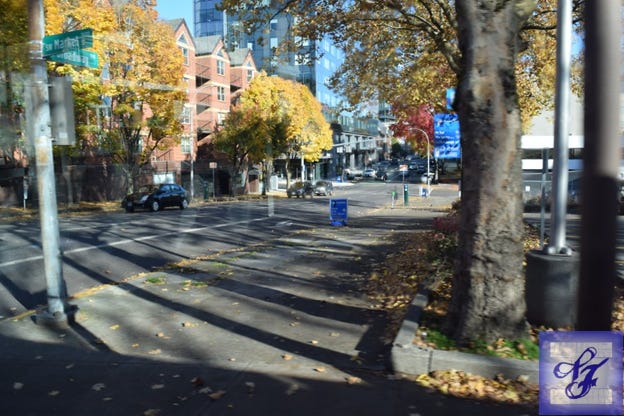12 Days of Walkable Urban: Day 5, Short blocks
Cue the choir 🎶: "Fiiiiiive hundred foot blooooccccccks!!!"
You can't talk about short blocks without talking about Portland--the place that showed us how far you can take this. Portland's blocks measure in at a miniscule 200' x 200'. If corner lots can sell for more, why not make all lots corner lots? (Maybe because it’s ok to have buildings in there somewhere—Seattle gets about 6-8% more developable land per block even with slightly wider streets and it’s still plenty walkable).
Ok, they probably took it a bit too far, but it is absolutely clear that short blocks make for a great walkable area. When we analyzed 200 locations throughout Tampa and Seattle in the SHRP2 Naturalistic Data set, it was clear that the shorter the blocks were, the more likely it was that a pedestrian would be there.
Short blocks are great for squirrelly attention spans--both in terms of pedestrians and drivers. Short blocks are fascinating--novelty lurks around every corner. Every interruption requires the driver to reorient their attention to the driving environment, which means that they have to stay fully engaged rather than drifting off into mindless driving.
That's why block length is one of the major variables that can be used to predict the speed of the traffic stream. Short blocks are slow blocks.
Is Access Management good or bad?
Which brings me to the issue of access management. Roadway engineers have noticed that every conflict brings an opportunity for a crash. That's perfectly true. Therefore, the typical engineering solution is to limit access using medians or directional driveways. If you have a bunch of close intersections and you’re trying to get good throughput, a bad access management plan will make a mess, as this image from Indiana DOT shows.
The unintended consequence is that it dramatically increases the speed of the vehicle flow, often by 5-10 mph or more. Every connection lost basically doubles the block length. Although, that eliminates some types of crashes—usually t-bone crashes, which are particularly nasty—it increases the crashes that come with u-turns. There's also an argument to be made that the increased speed in the corridor will make the crashes that remain far more serious.
More importantly, it increases the chance that people will cross wherever they want instead of crossing at a location where drivers expect them. A strict access management plan can be death to walkability. The higher speeds rightfully drive people away and the limited access makes crossing the river of vehicles a frogger-type exercise. Don’t get me wrong. I love a perfectly placed, marked mid-block crossing, but when blocks get beyond about 500 feet or so, people are just not going to walk down to the end of the block—I wouldn’t either. When I worked in downtown Orlando, I usually crossed at midblock to get to the restaurant across the street and that block was only 345 feet long. (I’m a traffic engineer because I’m the worst!!)
Access management has a place in our overall traffic management scheme. If you need to optimize vehicle flow to get drivers in and out, access management is your friend. Just don't try to have people walking or biking there--it slows your vehicles down and will kill someone. As a goal, throughput is in direct opposition to vulnerable user safety.
If, on the other hand, you're making a walkable area where people and bikes feel welcome, frequent access points and cross streets are a blessing. I was having a conversation with a friend from DDOT in Washington, DC last year and he made an interesting observation: although they try to consolidate driveways to eliminate conflicts between cyclists and drivers (a noble pursuit), he noticed, as a regular cyclist, that he felt far more safe cycling on a street that had a lot of driveways than one that didn't because of the way the vehicle traffic worked next to him. They were much more aware, going a lot slower, and usually had a lot less volume. It's a tough tradeoff.
Questions to ponder: Have you noticed the impact of block length on pedestrian activity in your neighborhood? What are your thoughts on balancing access management with walkability?
As we navigate the intricacies of block length and access management, it's clear that the choices we make in urban design have a profound impact on both traffic flow and walkability. Before we stroll into Day Six, where we'll tunnel into Enclosure, reflect on the streets in your own neighborhood. How does the balance between access and walkability shape your community? Share your insights in the comments below, and let's continue the dialogue on building cities that move and breathe seamlessly.






Unfortunately, no. I know signals are a key piece in today's urban spaces, but they aren't at the core of what it means to be urban. We had urban space long before we ever envisioned signals.
I do love a 60 second cycle, though!
Thanks for the shout out to Portland. 200 feet is pretty fantastic short block lengths that definitely gives people options when they're walking. If you combine these grids with narrow streets, you have a pretty effective network by which you can also manage speeds with signal coordination. Hopefully signal cycle lengths that are short make an appearance in the 12 days of Walkable Urban.